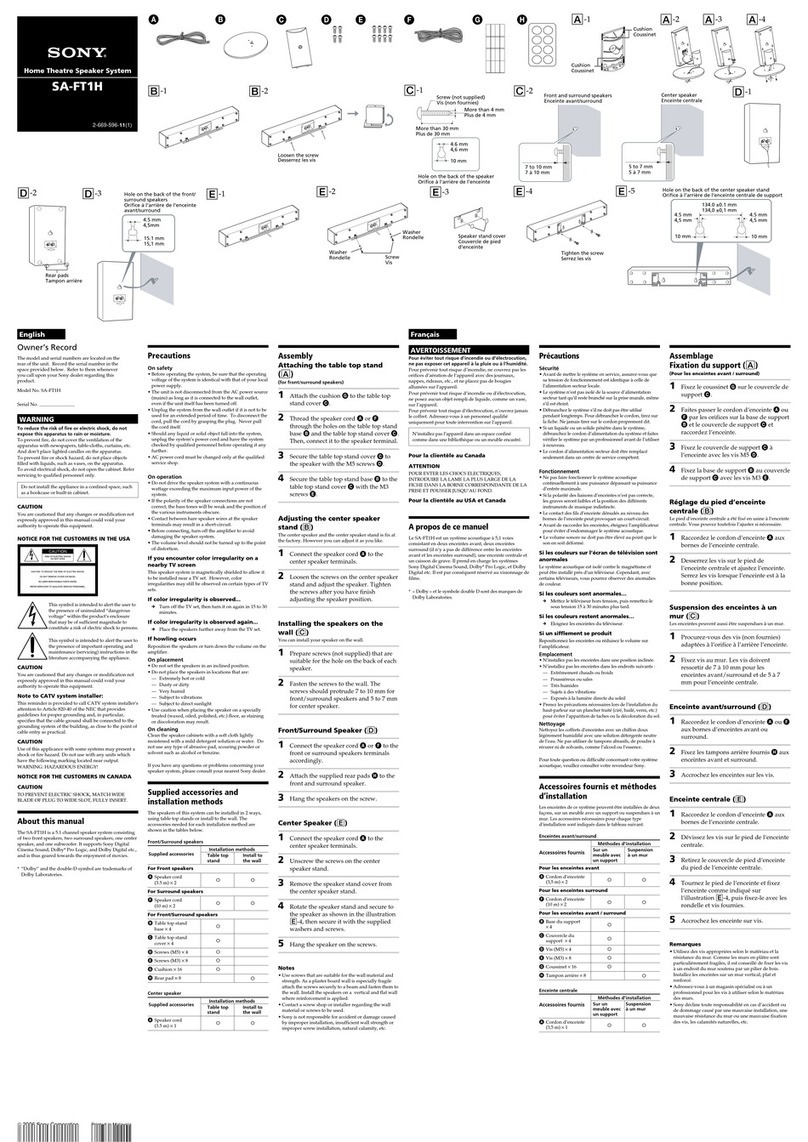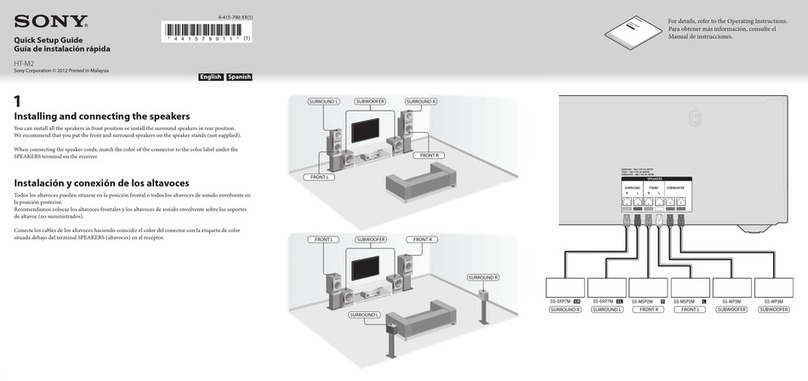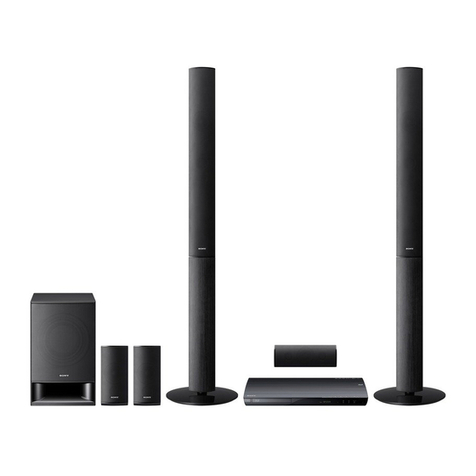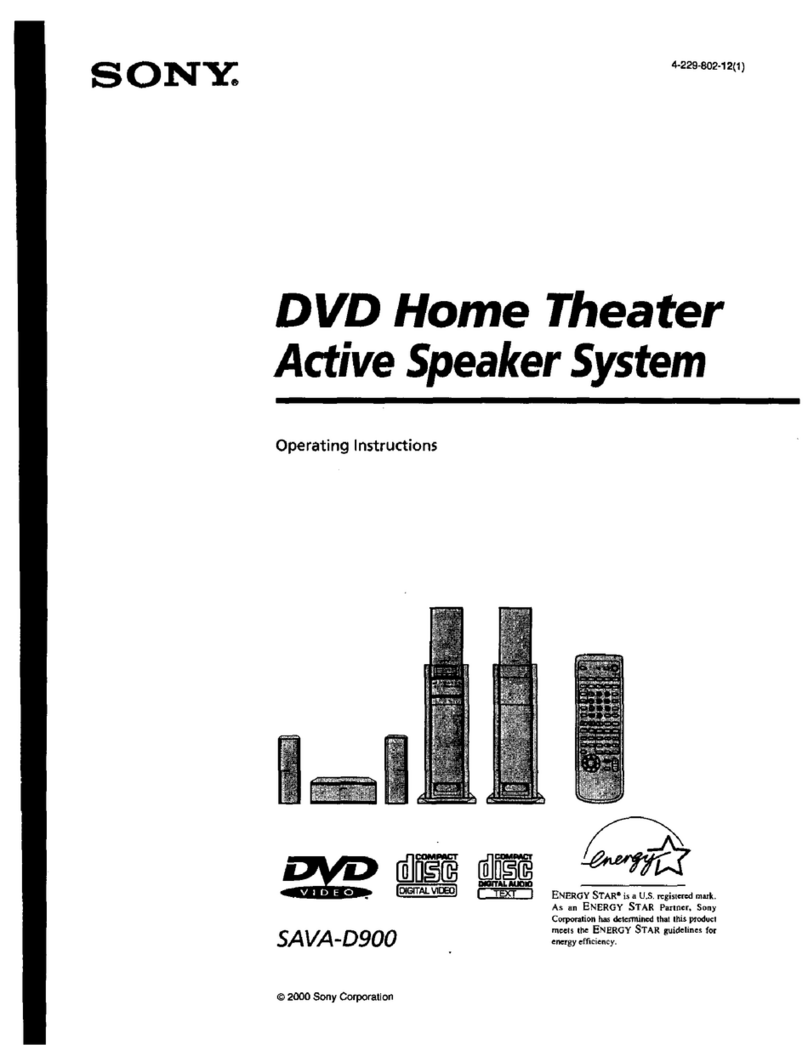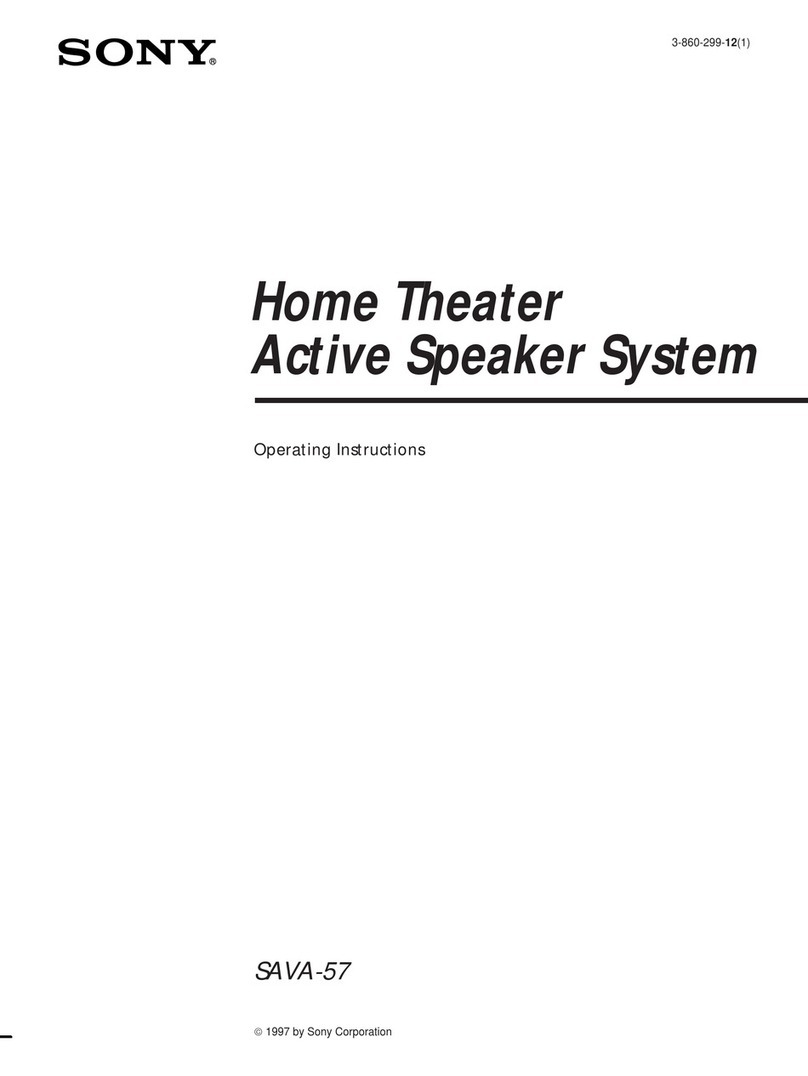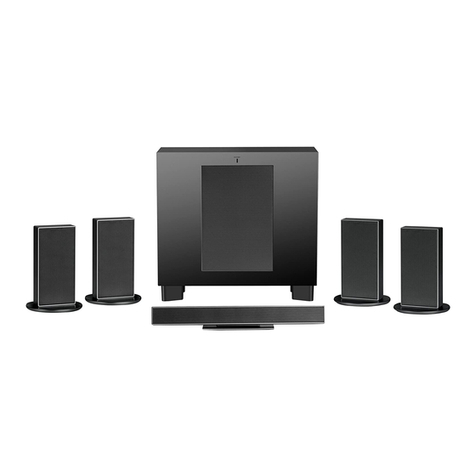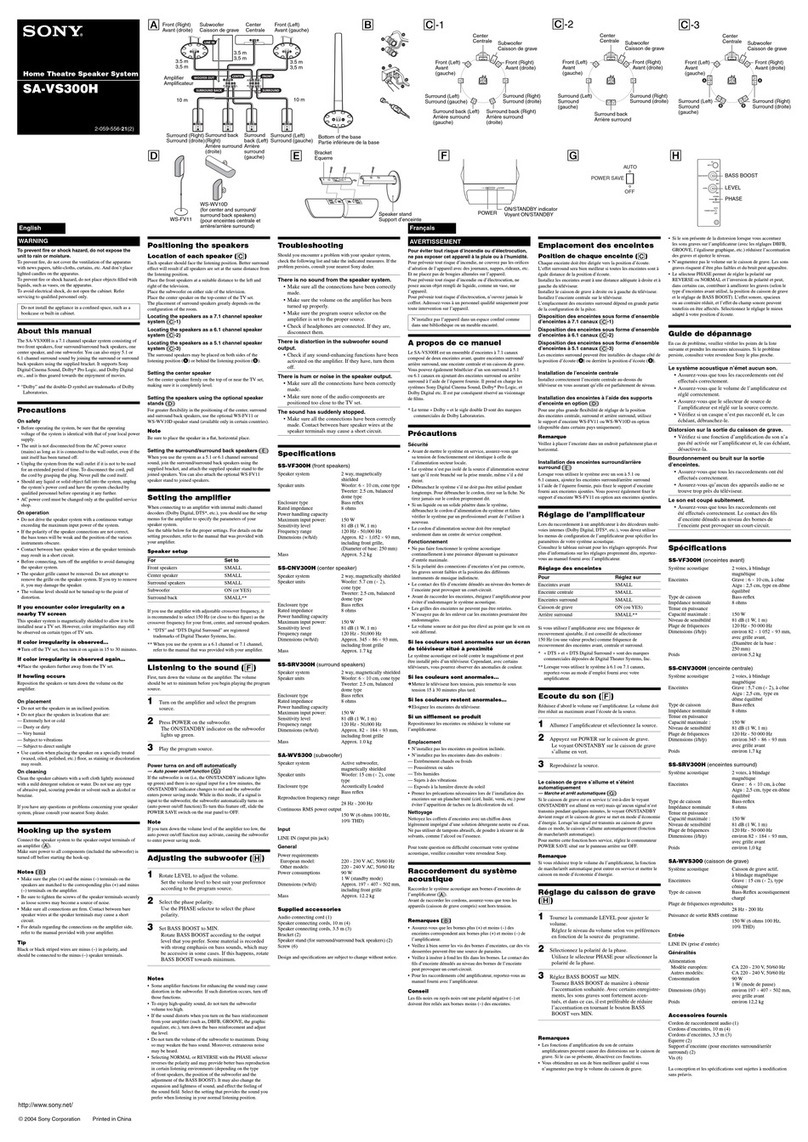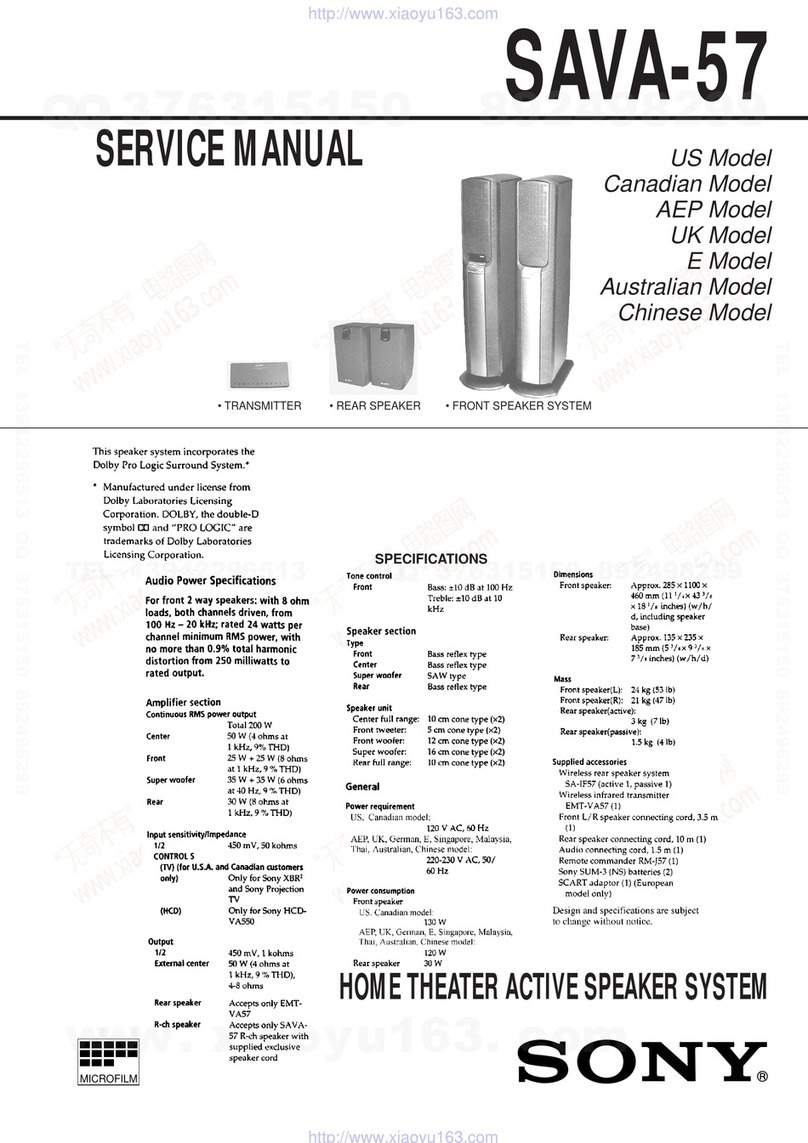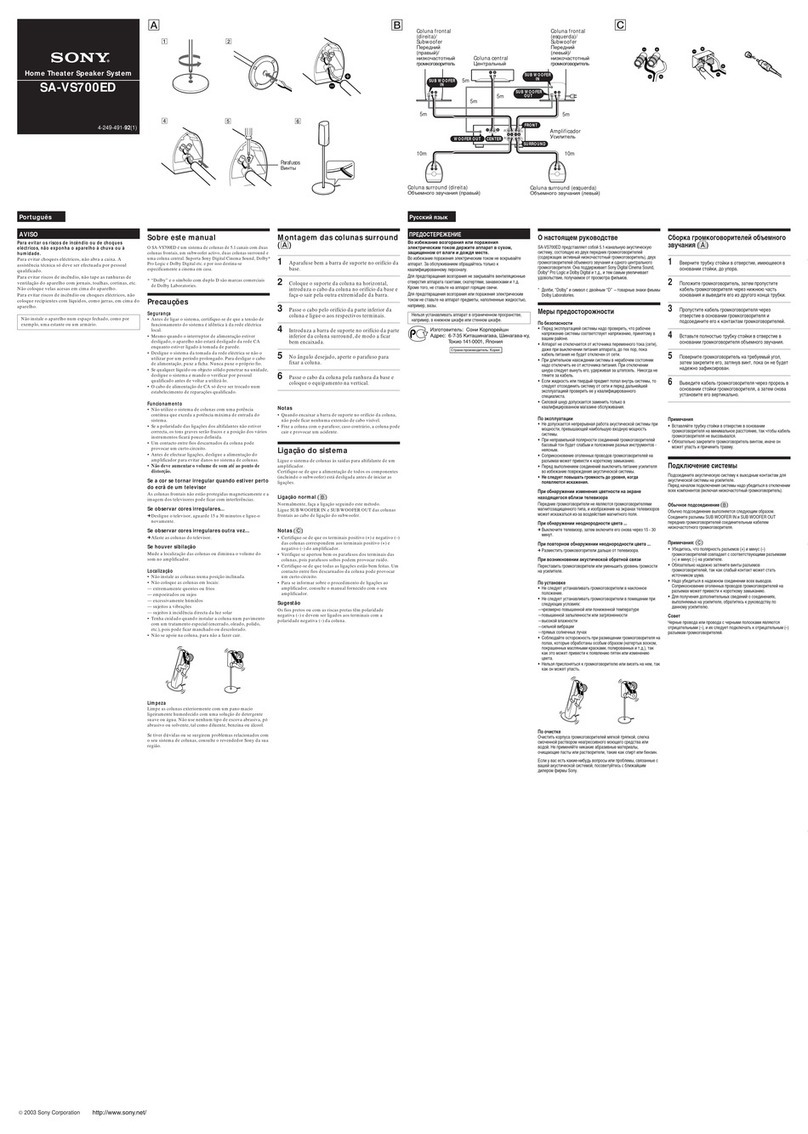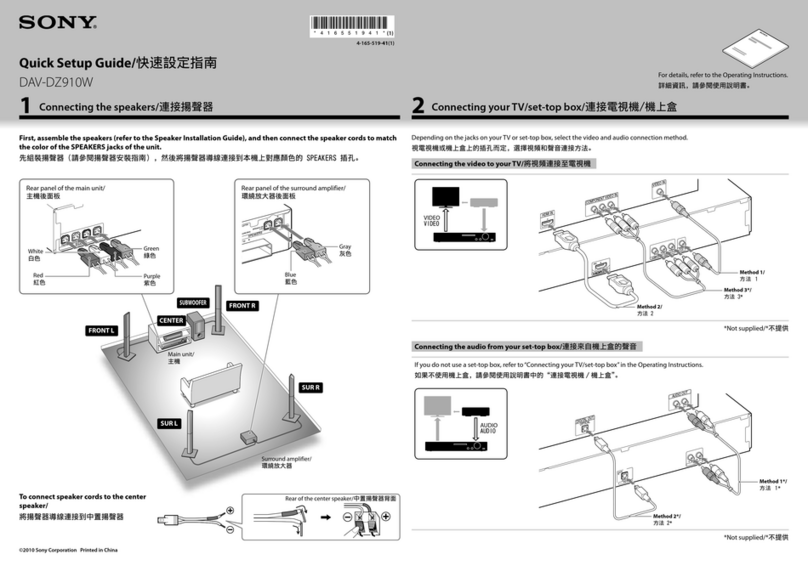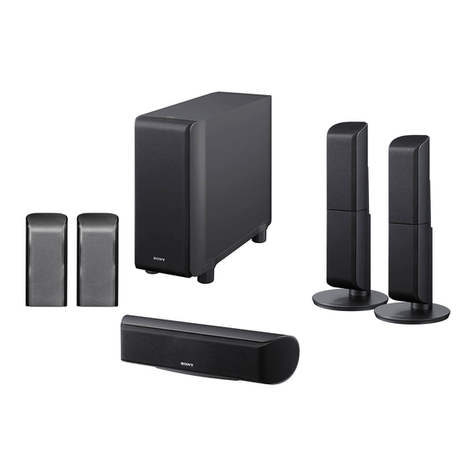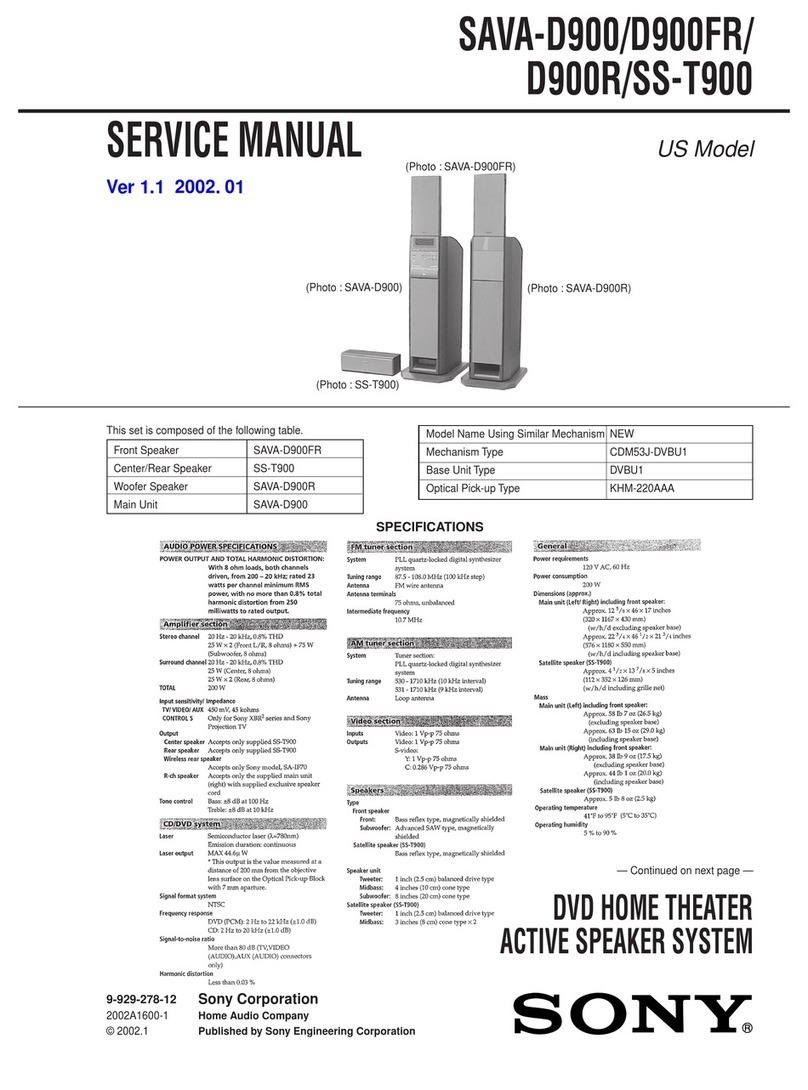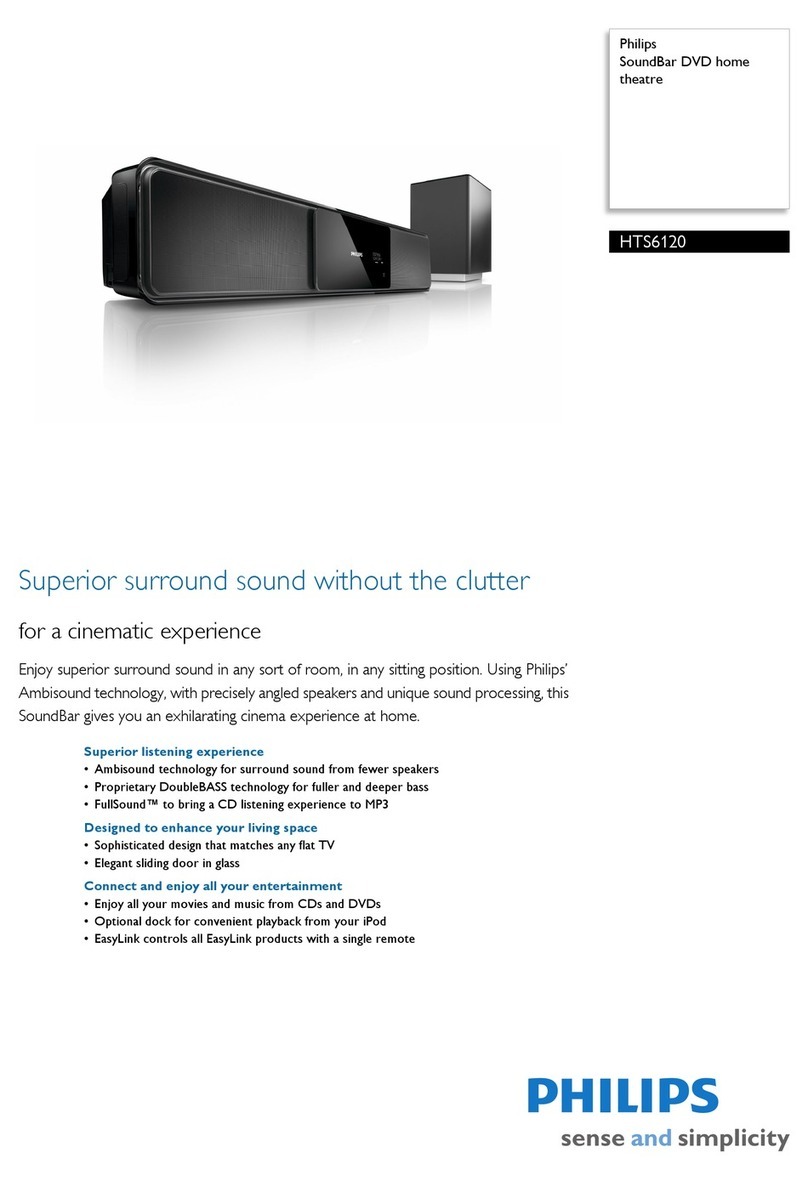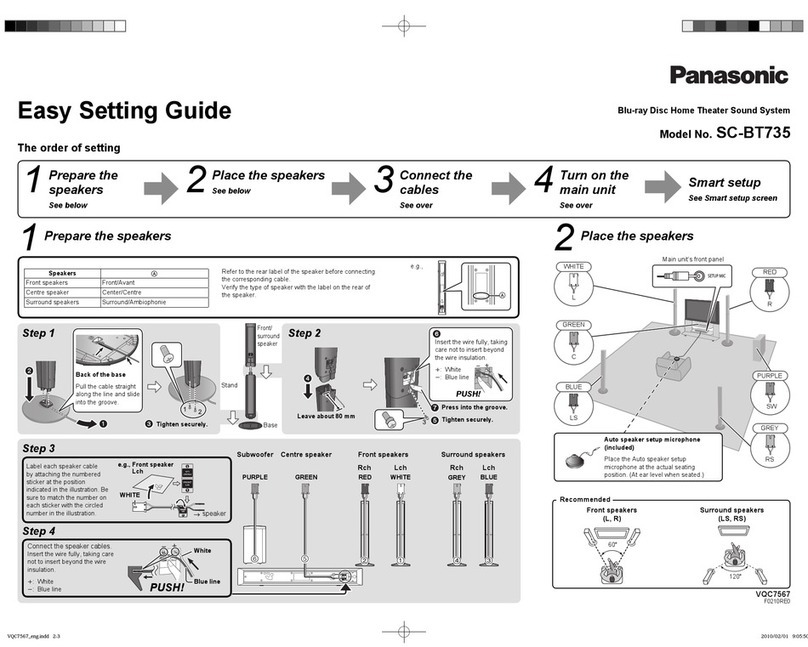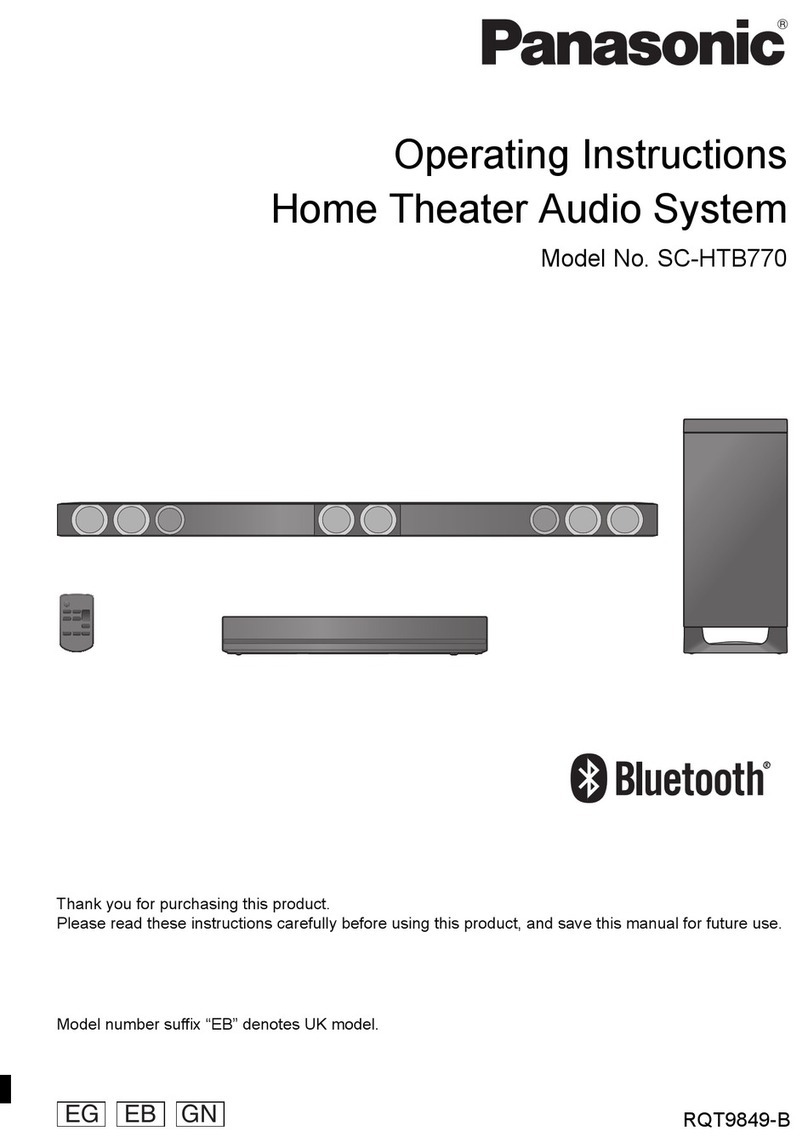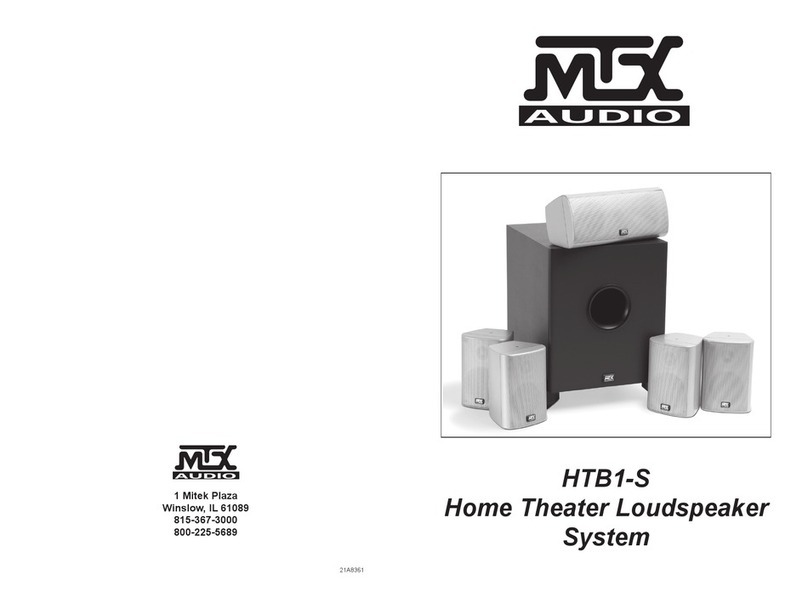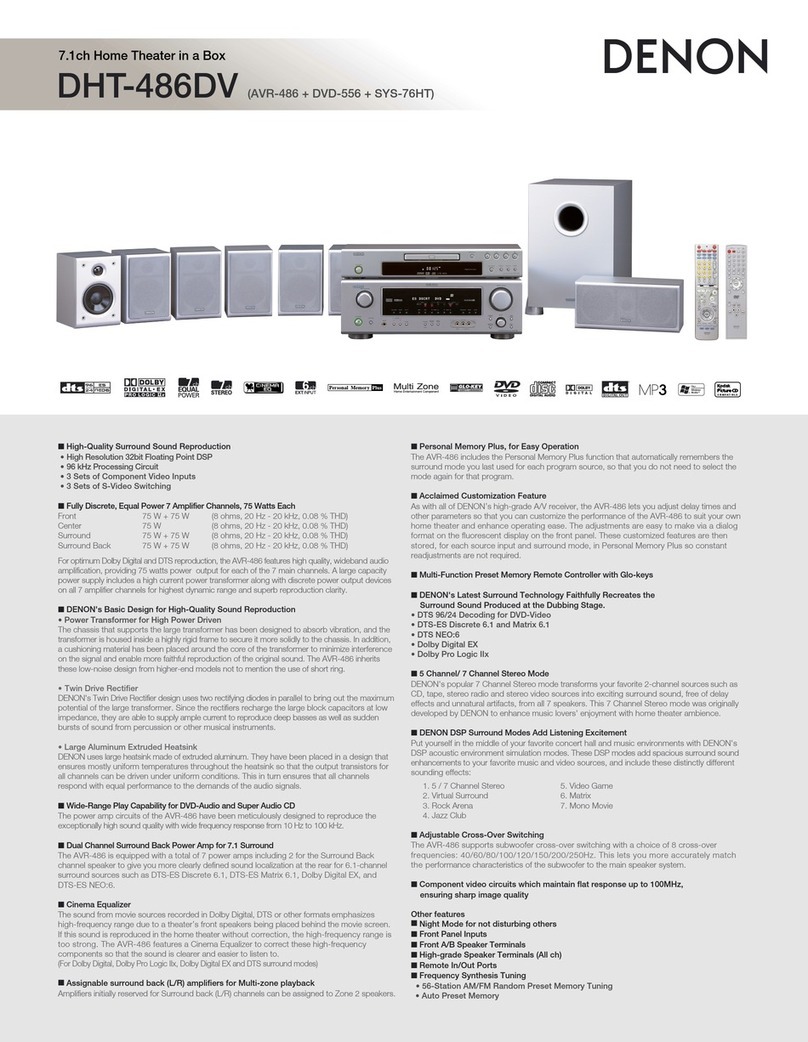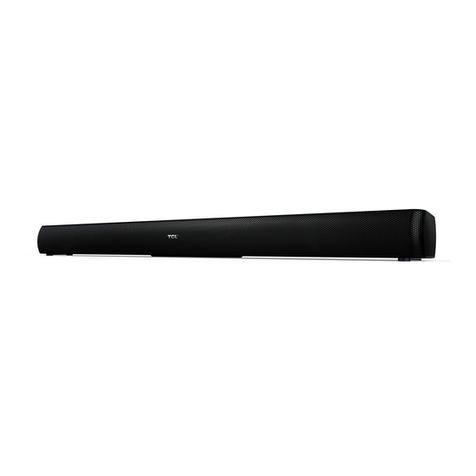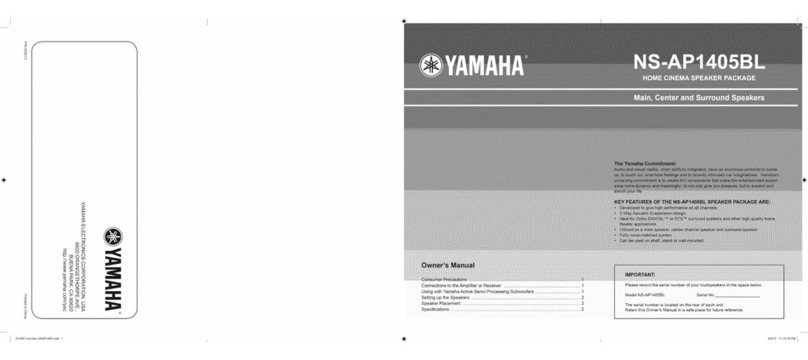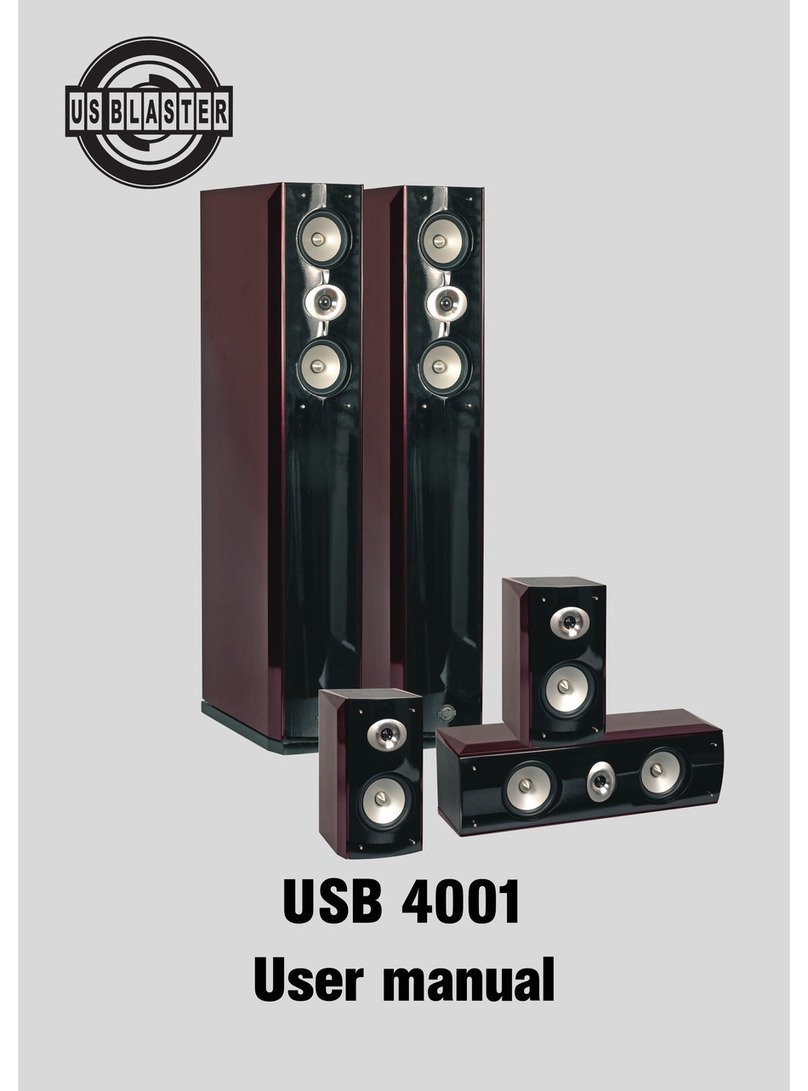
SERVICE MANUAL
Sony Corporation
Published by Sony Techno Create Corporation
HT-ST7
SA-ST7
SPECIFICATIONS
HT-ST7
HOME THEATRE SYSTEM
SA-ST7
ACTIVE SPEAKER SYSTEM
9-893-769-01
2013F33-1
© 2013.06
US Model
Canadian Model
AEP Model
UK Model
Australian Model
Ver. 1.0 2013.06
• All of the units included in the HT-ST7 (SA-
ST7/SA-WST7/EZW-RT50) are required to
confirming operation of SA-ST7. Check in
advance that you have all of the units.
COMPONENT MODEL NAME
HT-ST7
Sound Bar (Active Speaker System) SA-ST7
Subwoofer (Active Subwoofer) SA-WST7
Wireless transceiver EZW-RT50
• Please refer to service manual separately issued for Subwoofer.
As for EZW-RT50, the part number has been described to this
service manual.
Amplier section
U.S. models:
POWER OUTPUT AND TOTAL HARMONIC DISTORTION:
(FTC)
Front L + Front R:
With 4 ohms loads, both channels driven, from 200 - 20,000 Hz; rated
25 Watts per channel minimum RMS power, with no more than 1%
total harmonic distortion from 250 milliwatts to rated output.
POWER OUTPUT (reference)
Front L/Front R speaker blocks: 50 Watts (per channel at 4 ohms,
1kHz)
Center speaker block: 50 Watts (per channel at 4 ohms, 1 kHz)
Canadian models:
POWER OUTPUT (rated)
Front L + Front R: 35 W + 35 W
(at 4 ohms, 1 kHz, 1 % THD)
POWER OUTPUT (reference)
Front L/Front R speaker blocks: 50 Watts (per channel at 4 ohms,
1kHz)
Center speaker block: 50 Watts (per channel at 4 ohms, 1 kHz)
AEP, UK and Australian models:
POWER OUTPUT (rated)
Front L + Front R: 40 W + 40 W
(at 4 ohms, 1 kHz, 1 % THD)
POWER OUTPUT (reference)
Front L/Front R speaker blocks: 50 Watts (per channel at 4 ohms,
1kHz)
Center speaker block: 50 Watts (per channel at 4 ohms, 1 kHz)
Inputs
HDMI IN 1/2/3*
OPTICAL IN 1(TV)/2
ANALOG IN
COAXIAL IN
* These 3 jacks are identical. Using any of them makes no dierence.
Output
HDMI TV OUT (ARC)
BLUETOOTH section
Communication system
BLUETOOTH Specication version 3.0
Output
BLUETOOTH Specication Power Class 2
Maximum communication range
Line of sight approx. 10 m (33 ft)1)
Maximum number of devices to be registered
9 devices
Frequency band
2.4 GHz band (2.4000 GHz - 2.4835 GHz)
Modulation method
FHSS (Freq Hopping Spread Spectrum)
Compatible BLUETOOTH proles2)
A2DP (Advanced Audio Distribution Prole)
AVRCP 1.3 (Audio Video Remote Control Prole)
Supported Codecs3)
SBC4) , AAC5), aptX
Transmission range (A2DP)
20 Hz - 20,000 Hz (Sampling frequency 44.1 kHz)
1) The actual range will vary depending on factors such as obstacles
between devices, magnetic elds around a microwave oven, static
electricity, cordless phone, reception sensitivity, operating system,
software application, etc.
2) BLUETOOTH standard proles indicate the purpose of BLUETOOTH
communication between devices.
3) Codec: Audio signal compression and conversion format
4) Subband Codec
5) Advanced Audio Coding
Front L/Front R speaker blocks
Speaker system
2-way speaker system, Acoustic suspension
Speaker
Woofer: 65 mm (2 5/8 in) cone type, Magnetic uid speaker
Tweeter; 20 mm (13/16 in) dome type
Rated impedance
4 ohms
Center speaker block
Speaker system
Full range speaker system, Acoustic suspension
Speaker (5 speakers)
65 mm (2 5/8 in) cone type, Magnetic uid speaker
Rated impedance
4 ohms
General
Power requirements
120 V AC, 60 Hz (US and Canadian models)
220 V - 240 V AC, 50 Hz/60 Hz
(AEP, UK and Australian models)
Power consumption
On: 50 W (US and Canadian models)
On: 55 W (AEP, UK and Australian models)
“Control for HDMI” is o (Standby mode): 0.5 W or less
BLUETOOTH Standby mode: 0.5 W or less
Dimensions (approx.) (w/h/d)
1,080 mm × 109 mm × 110 mm (42 5/8 in × 4 3/8 in × 4 3/8 in)
(without grille frame, without stands)
1,080 mm × 109 mm × 129 mm (42 5/8 in × 4 3/8 in × 5 1/8 in)
(with grille frame, without stands)
1,080 mm × 129 mm × 138 mm (42 5/8 in × 5 1/8 in × 5 1/2 in)
(with grille frame, with stands)
1,080 mm × 129 mm × 130 mm (42 5/8 in × 5 1/8 in × 5 1/8 in)
(without grille fr am e, with stands)
Mass (approx.)
7.9 kg (17 Ib 6 5/8 oz) (with grille frame, with stands)
Wireless transceiver (EZW-RT50)
Communication System
Wireless Sound Specication version 1.0
Frequency band
5.736 GHz - 5.814 GHz (US and Canadian models)
5.725 GHz - 5.875 GHz (AEP, UK and Australian models)
Power requirements
DC 3.3 V, 300 mA
Modulation method
DSSS
Dimensions (approx.)
30 mm × 9 mm × 60 mm (1 3/16 in × 3/8 in × 2 3/8 in) (w/h/d)
Mass (approx.)
10 g (3/8 oz)
Digital audio input formats supported by the system
* It is possible to input these formats only with HDMI connection.
Dolby Digital DTS-HD Master Audio*
Dolby Digital Plus* DTS-HD High Resolution Audio*
Dolby TrueHD* DTS-HD Low Bit Rate*
DTS Linear PCM 2ch 48 kHz or less
DTS 96/24 Linear PCM Maximum 7.1ch 192 kHz or less*
– Continued on next page –
